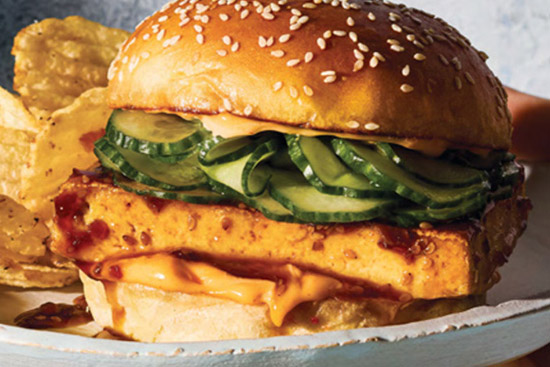TOFU

Additional info: About tofu
Like many soya foods, tofu originated in China. Legend has it that it was discovered about 2000 years ago by a Chinese cook who accidentally curdled soy milk when he added nigari seaweed. Introduced into Japan in the eighth century, tofu was originally called 'okabe'. Made from curdled soybean, tofu is relatively bland in its unadulterated form, but that’s also its secret weapon—once you learn a few tips and tricks, tofu can don almost any sauce or texture .
Ingredients
- Tofu
- Tofu recipes
Preparation
-
The 7 Main Types of Tofu And How to Cook With Them
From Firm to Silken, Know Which Type to Use
Silken Tofu
This style of tofu is complete with minimal curdling and processing, resulting in a product that is delicate in both texture and flavor. There are several ingredients that can be used to coagulate silken tofu, each producing a slightly different effect. For more jiggle and bounce, glucono delta lactone is added, whereas to achieve a softer result, nigari or gypsum is stirred in. Either way, it’s set in the same container it’s made in.
Historically, the Koreans enjoyed silken tofu in their jigae stew, while the Japanese incorporated it into hiyayakko, a simple dish made from chilled tofu and toppings with ginger, scallions, and soy sauce. Now, this doesn’t preclude silken tofu from packing a punch—it’s 40 percent protein, making it a lovely addition to your health-conscious smoothies, sauces, and even desserts.
Medium Tofu
In terms of texture, there is a range between silken and firm tofu that we’ll grant the ambiguous title of “medium.” This category of tofu has an additional step built into the process: pressing. After the soybean is sufficiently curdled, it’s transferred into a press that squeezes out most of its water. How you enjoy medium tofu is a matter of personal preference since its definition isn’t as firm (get it?) as others. That said, most agree it doesn’t hold up well when heavily handled, such as in a stir fry or on the grill. Try dropping it into miso soup or showcasing it in a Szechuan mapo tofu.
Firm Tofu
Firm tofu stands strong in a frying pan and excels as a meatless stand-in for a steak. Here again, this style encompasses several textures and as more water is pressed out of the curd, the firmer it becomes. Most firm varieties are popular in the West, so finding it is typically a cinch. Yet, if you fancy something on the far end of the spectrum such as su ji—a tofu so firm its name literally translates to “vegetarian chicken” in Chinese—your hunt may lead you to an Asian specialty store. If you have a taste for the traditional, try vegetarian potstickers, but if you like to reinvent the norm (and enjoy alliteration) give tofu tacos a go.
Tofu Skins
Also known as yuba in Japanese, tofu skins are made from successively peeling off the top layers that form while simmering soymilk. But if we’re being technical, tofu skins aren’t a tofu product at all—true tofu is made by adding a coagulant, whereas tofu skins coagulate from heat alone. Despite what they lack, tofu skins still make for a toothsome companion in many dishes! They can be found fresh or bought in a package, but if you choose the latter, you’ll need to rehydrate them before using. Serve 'em up as orange sesame yuba rolls or simply nest them in a soup. No matter how you get your hands on them, you’ll soon fall in love with their versatility and easy preparation.
Fermented Tofu
Fermented tofu may sound more dubious than delicious, but many compare its flavor to another familiar and well-loved food: cheese! It’s produced by inoculating tofu with mold, allowing the strains to proliferate for a few days, then packing it with a seasoned brine. There are many varieties of fermented tofu and each carries a distinct flavor, so be careful to follow your recipes precisely. Yet just as with cheese, you need not search long to find a dish it compliments just perfectly. Stir white fermented tofu in your bowl of congee or add red fermented tofu into a dipping sauce, destined for hot pot.
Aburaage Tofu
Mexico has the tortilla, Greece has the pita, and Poland has the pierogi—no matter where you are in the world, people enjoy stuffing their food into pockets and eating it. Aburaage is Japan’s answer to this. To make aburaage, tofu is cut into thin slices and fried until it puffs up and hollows out, ready for a variety of fillings. Although cooking with aburaage is a cinch, it’s best to boil it first to remove excess oil. Looking for something unhampered and delicious? Enter inarizushi. Or perhaps you craving a remix on your usual soup routine. This recipe for kitsune udon noodles should do the trick.
Shredded Tofu
In theory, shredded tofu is similar to other soy-based noodles, but in practice, they are light years tastier. You’ll likely spot them at an Asian specialty store sitting in their crinkly packaging, hankering to be used in any one of your usual noodle dishes. Just as with typical pastas, you’ll need to boil them first, but then it’s game on. Drizzle chili oil on top of a cold or hot shredded tofu noodle salad for a no-fail addition to your meal spread. Or drop them in the work with heaps of vegetables for a low-carb take on a noodle stir fry.
Source: www.thespruceeats.com

















